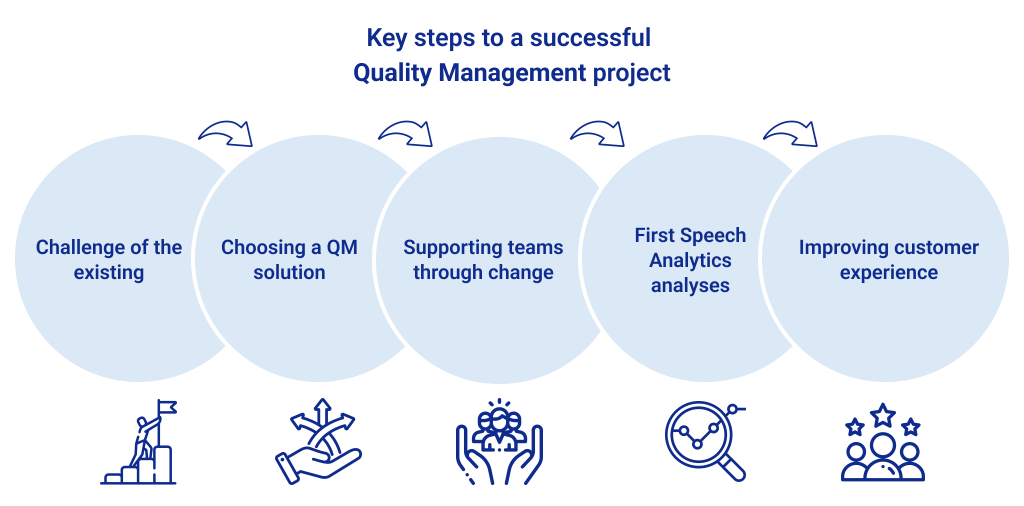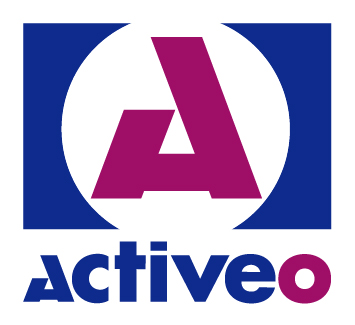Quality Management: Leveraging Sustainable Innovation
Recent studies show that companies that adopt advanced quality management tools have a customer retention rate that is 55% higher than the market average.
In addition, contact centers that integrate voice and emotion analysis see an average increase of 20 to 30% in customer satisfaction, as well as a 25% reduction in average handling time. These results translate into better performance by advisors, who can focus on more targeted and personalized responses that enhance the customer experience and loyalty.
There is also a reduction in turnover rates of around 33% in organizations that have implemented QM solutions. (source: Contact Center Quality Monitoring in 2025 – Callin)

What is QM?
Quality Management is a practice that allows the interaction between the contact center advisor and the customer to be evaluated. The main objectives of QM are:
- Analyzing the interaction between the advisor and the customer
- Monitoring advisors’ compliance with operational processes
- Optimizing team performance (coaching, targeted training)
- Ensuring compliance with standards (AFNOR, ISO, COPC)
- Improving the customer experience
- Building customer loyalty
All of this contributes to better overall customer service performance, at the heart of a 360° quality approach.
Increased customer relationship evaluation
With the development of Quality Monitoring tools, a whole list of parameters has been created to enable evaluators to go beyond the limitations imposed by the historical evaluation grid:

Whereas yesterday Quality Management focused on monitoring compliance with call management procedures and indicators such as response rates and times, or perceived quality, it now enables in-depth analysis of customer intent, advisor attitude, and process compliance.
It has enabled the implementation of advanced features such as speech and text analytics (transcription, semantic and sentiment analysis), report and dashboard generation, compliance monitoring, feedback, and targeted coaching.
These practices naturally enable managers and evaluators to act in real time, focus on high value-added tasks, stay closely attuned to customer expectations, and respond to strategic customer experience challenges.
Managers can now anticipate irritants, personalize training paths, and adjust processes based on operational data. This proactive approach allows practices to be more closely aligned with customer expectations, while strengthening team engagement.
One of the significant positive consequences of using a QM tool is strict compliance with current GDPR rules in terms of data processing, and the minimization of voice recording storage, as well as their copying and distribution by email or any other channel.
Another positive aspect of QM tools is the ability to quickly generate reports on specific topics, reproduce them, and distribute them (executive committee, team briefings, one-to-one meetings, HR management) with, for example:
- performance monitoring (collective/individual)
- measuring quality trends over time
- supporting managerial decisions (coaching, updating processes in place)
Quality assessment: traditional vs AI, the choice for organizations
Historically, quality control was a “manual” and time-consuming task. Grids were often created in Excel spreadsheets and took up a considerable amount of time for contact center evaluators, which limited the number of interactions that could be evaluated.
With advances in technology and the rise of AI, the discipline has evolved considerably and QM has been enhanced, offering users a wider range of possibilities, particularly with the contribution of AI! We are seeing the emergence of Automated Quality Management in quality approaches. Behind this innovation is artificial intelligence technology, as well as machine learning. Through semantic analysis, sentiment recognition, and automatic speech transcription, AQM enriches and automates quality control, making it incomparably more efficient and relevant (impartiality and objectivity are guaranteed through AI analysis, thus eliminating any risk of human bias).
This ensures compliance, generates instant reports, and enables the deployment of targeted action plans based on identified issues. In addition, AQM provides real-time alerts on any decline in the quality performance of an agent or group of agents. This means that corrective action can be taken quickly: adjusting a process, organizing personalized coaching, etc. The level of detail that AQM can provide also makes it easier for evaluators and managers to detect weaknesses in terms of soft skills or attitude, and to suggest adjustments, coaching, and personalized discussions.
The choice between traditional quality management and Automated Quality Management depends on several key factors: size of the organization, volume of calls received/made, field of activity, objectives/KPIs set.

For example, the publisher Verint offers a “Quality Bot” solution that enables:
- analysis of high call volumes
- sentiment analysis
- automation of repetitive and scripted interactions
- real-time responsiveness
- legal compliance (GDPR)
- full compliance with AFNOR, COPC, and other standards
- management of multi-site and multilingual centers.
As a result, AQM is particularly well suited to organizations that handle high call volumes, are subject to strict regulatory requirements, and are highly sensitive to legal compliance (e.g., GDPR), AFNOR standards, COPC standards, etc., as well as companies with multi-site, multilingual contact centers. The COPC standard, widely recognized in the contact center sector, imposes methodological rigor in terms of quality management, interaction traceability, and continuous improvement. In this context, AQM is a powerful lever for meeting these requirements while facilitating process harmonization, particularly in multi-site and multilingual environments.
In a spirit of gradual and controlled evolution, it is recommended to begin the transition to Automated Quality Management (AQM: partial or total) by first structuring the foundations of operational management. This involves implementing a recording tool to capture interactions, followed by a Workforce Management (WFM) solution to optimize planning, and then a Quality Management (QM) module to structure the evaluation. Once these building blocks are in place, the integration of AQM makes it possible to automate large-scale analysis, objectify evaluations, and enhance responsiveness in quality management.

Key takeaways…
In a context where customer experience is becoming a strategic lever for differentiation, Quality Management is emerging as a performance and engagement accelerator that organizations must adopt. Thanks to their increasingly numerous features, QM and AQM have won over companies by helping them improve their relational performance. Our customers who have integrated the solution into their organizations report concrete benefits such as significant time savings, automation of repetitive tasks, and enhanced structuring of their quality processes. This transformation enables them to take a decisive step toward relational and operational excellence.
Why choose Activeo?
As a committed player in the customer relations ecosystem, Activeo has been a member of the AFNOR “NF345 – Customer Relations” brand committee and the ISO “Service Excellence” standardization committee for many years, actively contributing to the development of customer relations standards.
As a partner of QM solution providers such as Verint, Calabrio, Amazon Connect from AWS, and others, Activeo offers its combined technical and business expertise to successfully complete this type of project, from the initialization phase to configuration and user training.
A value proposition to support your QM project:
![]() Over 25 years of expertise in this type of project
Over 25 years of expertise in this type of project
![]() A “WFO practice” that combines functional, business, and technical experts, a proven methodology, and certifications
A “WFO practice” that combines functional, business, and technical experts, a proven methodology, and certifications
![]() The assurance of a successful project: change management, support, innovations in optimizing QM practices adapted to the context
The assurance of a successful project: change management, support, innovations in optimizing QM practices adapted to the context
![]()
An operational model that provides for project management and collaboration with the publisher, in co-construction with the business and IT teams.
![]() Development and configuration capabilities within the framework of IS integration, multi-channel solutions, HRIS, time management, etc.
Development and configuration capabilities within the framework of IS integration, multi-channel solutions, HRIS, time management, etc.
This article is brought to you by:

Lucie Ossepian
Consultant
Would you like to find out how these solutions can fit into your operational roadmap? Would you like to learn more about Activeo's support approach? Contact our experts for a personalized demonstration and a contextual discussion.
